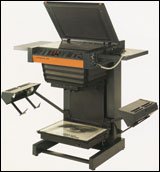Mac064
Member
- Joined
- Oct 20, 2008
- Messages
- 94
- Format
- Holga
Hi there all,
I hope it isn't a daft one but I want to do some photogravure work using photopolymer plates. Although maybe not the most popular process (maybe becasue of the need for an etching press, plates, inks etc) I want to give it a go and have done a fair bit of reading up on the process. One thing that many practitioners mention is the need for a vacuum press to make sure that the contact between the polymer plate and the positive (and indeed the aquatint screen if you use one) is as good as you can make it. Many (if not most) therefore reccommend highly using a vacuum frame. I don't have one, do not have access to one either and am unlikely to get one soon (they are not cheap). I was wondering how much degredation there is when not using one in the photogravure process.
I assume that in the heady days when photogravure work was at it's height, Alvin Coburn, Demachy and the greats did not have flash vaccuum frames either (or did they?). I guess they simply used a single light source (the sun) and glass frames. Their work that was hardly that shabby! In my other alternative process work, I have used very heavy plate glass or vintage split back contact frames which have been fine for my purposes.
Anyway, before I start cutting the polymer plates and giving it all a go I just wanted to ask out in the community if anyone had a similar problem to tackle and the results they achieved with and without using a vacuum frame. I know that I am probably just going to give it a go without a frame but I would be very interested in any thoughts. I have posted on Hybrid to canvass opinions there too.
Thanks for your consideration.
I hope it isn't a daft one but I want to do some photogravure work using photopolymer plates. Although maybe not the most popular process (maybe becasue of the need for an etching press, plates, inks etc) I want to give it a go and have done a fair bit of reading up on the process. One thing that many practitioners mention is the need for a vacuum press to make sure that the contact between the polymer plate and the positive (and indeed the aquatint screen if you use one) is as good as you can make it. Many (if not most) therefore reccommend highly using a vacuum frame. I don't have one, do not have access to one either and am unlikely to get one soon (they are not cheap). I was wondering how much degredation there is when not using one in the photogravure process.
I assume that in the heady days when photogravure work was at it's height, Alvin Coburn, Demachy and the greats did not have flash vaccuum frames either (or did they?). I guess they simply used a single light source (the sun) and glass frames. Their work that was hardly that shabby! In my other alternative process work, I have used very heavy plate glass or vintage split back contact frames which have been fine for my purposes.
Anyway, before I start cutting the polymer plates and giving it all a go I just wanted to ask out in the community if anyone had a similar problem to tackle and the results they achieved with and without using a vacuum frame. I know that I am probably just going to give it a go without a frame but I would be very interested in any thoughts. I have posted on Hybrid to canvass opinions there too.
Thanks for your consideration.












